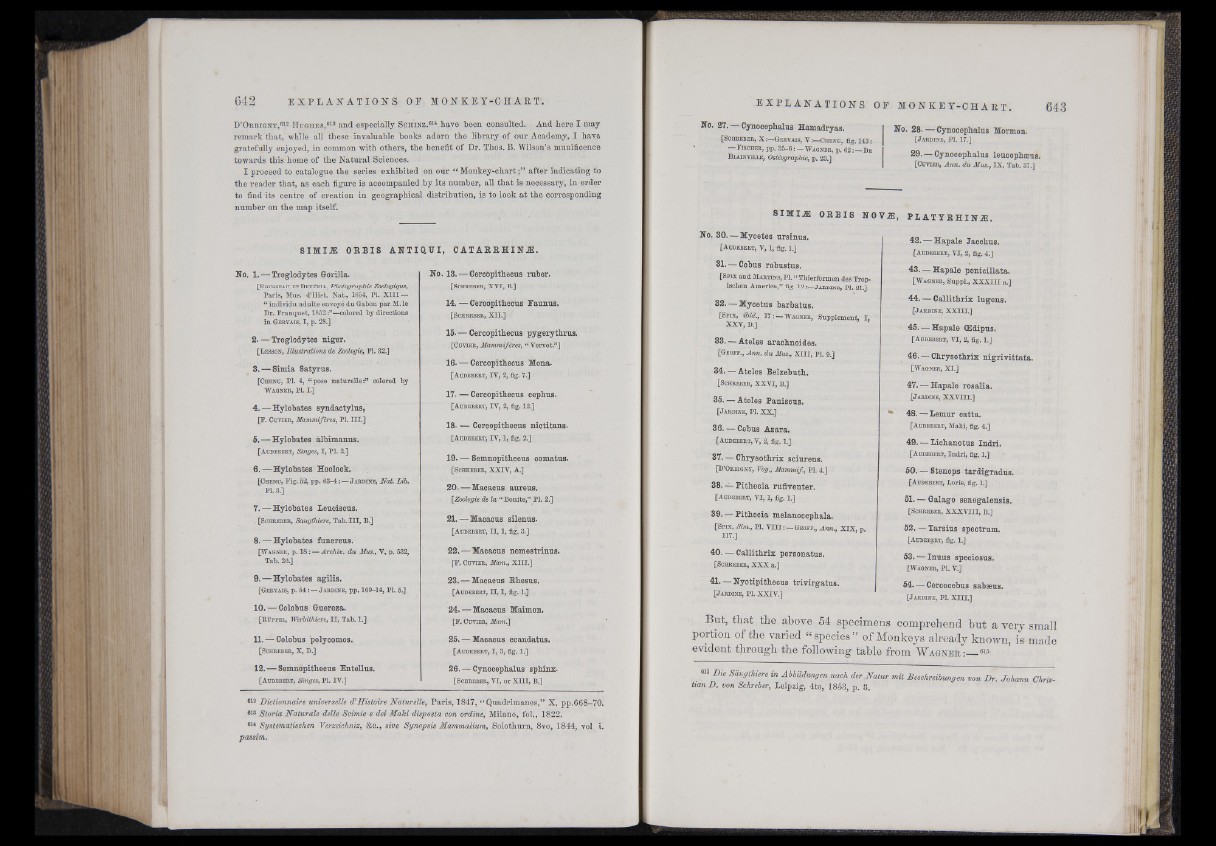
D’Orbign y ,612 H ughes,613 and especially Schin z.614 have been consulted. And here I may
remark that, while all these invaluable books adorn the library of our Academy, I have
gratefully enjoyed, in common with others, the benefit of Dr. Thos. B. Wilson’s munificence
towards this home of the Natural Sciences.
I proceed to catalogue the series exhibited on our “ Monkey-chart;” after indicating to
the reader that, as each figure is accompanied by its number, all that is necessary, in order
to find its centre of creation in geographical distribution, is to look at the corresponding
number on the map itself.
S IMIÆ ORBIS ANTIQTTI, CATARRHINÆ.
No. 1.—Troglodytes Gorilla.
[Rousseau e t Devérïa, Photographie Zoologique,
Paris, Mus. d’Hist. Nat., 1854, Pi. X III —
“ individu adulte envoyé du Gabon par M. le
Dr. Franquet, 1852:”—colored by directions
in Gervais, I, p. 28.]
2- — Troglodytes niger.
[Lesson, Illustrations de Zoologie, Pl. 82.]
3. — Simia Satyrus.
[Chenu, Pl. 4, “ pose naturelle:” colored by
Wagner, Pl. I.]
4. — Hylobates syndactylus,
[F. Cuveer, Mammifères, Pl. m .]
5. — Hylobates âlbimanus.
[Audebert, Singes, I, Pl. 2.]
6. — Hylobates Hoolock.
[Chenu, Fig. 62, pp. 63-4 :—Jardine, Mat. Lib.
Pl. 3.]
7. — Hylobates Leuciscus.
• [Schreber, Saugthiere, Tab. «III, B.]
8. — Hylobates funereus.
[W a g n e r , p. 18 : —Archiv, du Mus., Y, p. 532,
Tab. 26.]
9. — Hylobates agilis.
[Gervais^ p. 5 4:—Jardine, pp. 109-14, Pl. 5.]
10. — Colobus Guereza.
[ R ü p p e l , Werbithiere, II, Tab. 1.]
11. — Colobus polycomos.
[Schreber, X, D.]
12. — Semnopithecus Entellus.
No. 13.— CercOpithecus ruber.
[S c h r e b e r , XVI, B.]
14. — Cercopithecus Faunus.
[S c h r e b e r , XII.]
15. — Cercopithecus pygerythrus.
[C u v ie r , Mammifères, “ Vervet.”] A •
16.M- Cercopithecus Mona.
[A u d e b e r t , IV, 2 , fig. 7 .]
17- — Cercopithecus cephus.
[A u d e b e r t , IV, 2 , fig. 12.]
18. — Cercopithecus nictitans.
[A u d e b e r t , IV, 1, fig. 2 .]
19. — Semnopithecus comatus.
[S c h r e b e r , XXIV, A.]
2 0 .—Macacus aureus.
[.Zoologie d e là “ Bonite,” Pl. 2 .]
21.— Macacus silenus.
[A u d e b e r t , II, 1, fig. 3.]
22.—Macacus némestrinus.
[F. C u v ie r , Mam., XIII.]
23. — Macacus Rhésus.
[A u d e b e r t , II, 1, fig. 3.]
24. — Macacus Maimon.
[F. C u v ie r , Mam.]
25. — Macacus ecandatus.
[A u d e b e r t , I, 3, fig. 1.]
[ A u d e b e r t , S in g e s , Pl. IV.]
26. — Cynocephalus sphinx.
[ S c h r e b e r , VI, o r XIII, B.]
612 Dictionnaire universelle d>Histoire Naturelle, Paris, 1847, “ Quadrimanes,” X, pp.668-70.
613 Storia Naturale delle Scimie e dei Maki disposta con ordine, Milano, fol., 1822.
614 Systematischen Verzeichnis, &c., sive Synopsis Mammalium, Solothurn, 8vo, 1844, voi i.
passim.
No. 27. — Cynocephalus Hamadryas.
[Schreber, X .‘—Gervais, V :—Chenu, fig. 143 :
— Fischer, pp. 35-6; — Wagner, p. 62:—Db
Blain ville, Ostéographie, p. 23.]
No. 2 8 .— Cynocephalus Mormon.
[Jardine, PI. 17.]
29. — Cynocephalus leucophæus.
[C u v ie r , Ann. dû Mus., IX, Tab. 37.]
S IMIÆ OEEIS NOVÆ, PLATYEHINÆ.
No. 30. — Mycetes ursinus.
[Audebert, V, 1, fig . 1.]
31. — Cebus robustus.
[Spix and Martins, PI. “ Thierformen des Tropischen
America,” fig. 12:—-Jardine, PI. 21.]
32. — Mycetus barbatus.
[Spix, ibid., 17: — Wagner, Supplement, I,
XXV, D.]
33. — Ateles arachnoides.
[Geoff., Ann. du Mus., XIII, Pl. 9.]
34. — Ateles Belzebuth.
[Schreber, XXVI, B.]
35. — Ateles Paniscus.
[Jardine, Pl. XX.]
36. — Cebus Azara.
[Audebert, V, 2, fig . 1.]
37. — Chrysothrix sciureus.
[D’Orbigny, V o y ., Mammif, Pl. 4.]
38. — Pithecia rufiventer.
[Audebert, VI, 1, fig . 1.]
3 9 ¿ r Pithecia melanocephala.
[Spix, Sim., Pl. VHI: —Geoff., Ann., yty, p.
117.]
40. — Callithrix personatus.
[Sohreber, XXX a.]
41. — Nyotipithecus trivirgatus.
[Jardine, Pl. XXIV.]
42. — Hapale Jacchus.
[A u d e b e r t , VI, 2, fig. 4.]
43. —Hapale penicillata.
[W a g n e r , Suppl., XXXTTI a.]
44. — Callithrix lugens.
[ J a r d in e , XXHX]
45. — Hapale (Edipus.
[Audebert, VI, 2, fig. l.J
46. — Chrysothrix nigrivittata.
[W a g n e r , XI.]
47. — Hapale rosalia.
[ J a r d in e , XXVIII.]
^ 48. — Lemur catta.
[A u d e b e r t , Maki, fig. 4.]
49. — Lichanotus Indri.
[ A u d e b e r t , Indri, fig. 1.]
50. — Stenops tardigradus.
[A u d e b e r t , Loris, fig. 1.]
51. — Galago senegalensis.
[ S c h r e b e r , X X X V n i, B.]
52. — Tarsius spectrum.
[A u d e b e r t , fig. 1.]
53. — Inuus speciosus.
[W a g n e r , Pl. V.]
54. — Cercocebus sabæus.
[ J a r d in e , Pl. X III.]
But, that the above 54 specimens comprehend but a very small
portion of the varied “ species” of Monkeys already known, is made
evident through the following table from W agner 615 •
618 Die Saugthiere in Abbildungen.nach der Natur mit Beschreibungen von Dr. Johann Chris-
tianD. von Sehr eher, Leipzig, 4to, 1853, p. 3.